Protective Effect of Processed Polygoni multiflori Radix and Its Major Substance during Scopolamine-Induced Cognitive Dysfunction
Abstract
1. Introduction
2. Materials and Methods
2.1. Reagents
2.2. Preparation of PPM
2.3. Analysis of Phytochemical Compounds
2.4. Animals and Treatment
2.5. Behavioural Studies
2.5.1. Novel Object Recognition Test
2.5.2. Passive Avoidance Test
2.5.3. Morris Water Maze Test
2.6. AChE Activity and ACh Concentration in Brain
2.7. Western Blot Analysis
2.8. Statistical Analysis
3. Results
3.1. Phytochemical Contents of PPM
3.2. PPM and TSG Ameliorate Scopolamine-Induced Cognitive Dysfunctions in Behavioural Tests
3.2.1. NOR Test
3.2.2. PA Test
3.2.3. MWM Test
3.3. PPM and TSG Attenuate Scopolamine-Induced Cholinergic System Dysfunctions in the Brain
3.4. PPM and TSG Upregulate BDNF Expression in Scopolamine-Induced Brain
3.5. PPM and TSG Inhibit Scopolamine-Induced Neural Apoptosis in the Brain
4. Discussion
5. Conclusions
Supplementary Materials
Author Contributions
Funding
Institutional Review Board Statement
Informed Consent Statement
Data Availability Statement
Acknowledgments
Conflicts of Interest
References
- Sriram, V.; Jenkinson, C.; Peters, M. Informal carers’ experience and outcomes of assistive technology use in dementia care in the community: A systematic review protocol. Syst. Rev. 2019, 8, 1–6. [Google Scholar] [CrossRef]
- Singh, A.; Sarkar, A.; Irwin, M.; Singh, A.; Riccetti, M. Alzheimer′s disease: The silver tsunami of the 21st century. Neural Regen. Res. 2016, 11, 693–697. [Google Scholar] [CrossRef] [PubMed]
- Tramutola, A.; Lanzillotta, C.; Perluigi, M.; Butterfield, D.A. Oxidative stress, protein modification and Alzheimer disease. Brain Res. Bull. 2017, 133, 88–96. [Google Scholar] [CrossRef] [PubMed]
- Pilipenko, V.; Narbute, K.; Amara, I.; Trovato, A.; Scuto, M.; Pupure, J.; Jansone, B.; Poikans, J.; Bisenieks, E.; Klusa, V.; et al. GABA-containing compound gammapyrone protects against brain impairments in Alzheimer’s disease model male rats and prevents mitochondrial dysfunction in cell culture. J. Neurosci. Res. 2019, 97, 708–726. [Google Scholar] [CrossRef] [PubMed]
- Calsolaro, V.; Antognoli, R.; Okoye, C.; Monzani, F. The use of antipsychotic drugs for treating behavioral symptoms in Alzheimer’s disease. Front. Pharmacol. 2019, 10, 1465. [Google Scholar] [CrossRef] [PubMed]
- Yiannopoulou, K.G.; Papageorgiou, S.G. Current and future treatments for Alzheimer’s disease. Ther. Adv. Neurol. Disord. 2012, 6, 19–33. [Google Scholar] [CrossRef] [PubMed]
- Mahdy, K.; Shaker, O.; Wafay, H.; Nassar, Y.; Hassan, H.; Hussein, A. Effect of some medicinal plant extracts on the oxidative stress status in Alzheimer’s disease induced in rats. Eur. Rev. Med. Pharmacol. Sci. 2012, 16, 31–42. [Google Scholar]
- Zhang, M.; Xie, M.; Wei, D.; Wang, L.; Hu, M.; Zhang, Q.; He, Z.; Peng, W.; Wu, C. Hydroxy-α-sanshool isolated from Zanthoxylum bungeanum attenuates learning and memory impairments in scopolamine-treated mice. Food Funct. 2019, 10, 7315–7324. [Google Scholar] [CrossRef] [PubMed]
- Lin, L.; Ni, B.; Lin, H.; Zhang, M.; Li, X.; Yin, X.; Qu, C.; Ni, J. Traditional usages, botany, phytochemistry, pharmacology and toxicology of Polygonum multiflorum Thunb.: A review. J. Ethnopharmacol. 2015, 159, 158–183. [Google Scholar] [CrossRef] [PubMed]
- He, Y.; Wang, F.; Chen, S.; Liu, M.; Pan, W.; Li, X. The protective effect of Radix Polygoni Multiflori on diabetic encephalopathy via regulating myosin light chain kinase expression. J. Diabetes Res. 2015, 2015, 484721. [Google Scholar] [CrossRef] [PubMed]
- Park, H.-J.; Zhang, N.; Park, D.K. Topical application of Polygonum multiflorum extract induces hair growth of resting hair follicles through upregulating Shh and β-catenin expression in C57BL/6 mice. J. Ethnopharmacol. 2011, 135, 369–375. [Google Scholar] [CrossRef]
- Wang, G.; Shang, J.; Wu, Y.; Ding, G.; Xiao, W. Rapid characterization of the major chemical constituents from Polygoni Multiflori Caulis by liquid chromatography tandem mass spectrometry and comparative analysis with Polygoni Multiflori Radix. J. Sep. Sci. 2017, 40, 2107–2116. [Google Scholar] [CrossRef]
- Wei, Y.; Liu, M.; Liu, J.; Li, H. Influence factors on the hepatotoxicity of Polygoni Multiflori Radix. Evid. Based Complement. Altern. Med. 2019, 2019, 5482896. [Google Scholar] [CrossRef] [PubMed]
- Liu, Y.; Wang, Q.; Yang, J.; Guo, X.; Liu, W.; Ma, S.; Li, S. Polygonum multiflorum Thunb.: A review on chemical analysis, processing mechanism, quality evaluation, and hepatotoxicity. Front. Pharmacol. 2018, 9, 364. [Google Scholar] [CrossRef]
- Ye, Z.-G.; Zhang, G.-P.; Zhang, H.-J.; Chen, T.-F.; Hou, H.-P.; Su, P.; Gao, Y.-H.; Yang, Y.-F. Screening and identifying hepatotoxic components in Polygoni multiflori radix and Polygoni multiflori radix praeparata. World J. Tradit. Chin. Med. 2019, 5, 173. [Google Scholar] [CrossRef]
- Kim, H.Y.; Kim, J.Y.; Cho, E.J.; Choi, J.M.; Hwang, C.E.; Lee, H.Y.; Ahn, M.J.; Lee, J.H.; Kim, Y.-G.; Ko, K.H.; et al. Free radical scavenging effect and oxidative stress protective activity of domestic processed Polygoni Multiflori Radix. J. Korean Soc. Food Sci. Nutr. 2015, 44, 809–815. [Google Scholar] [CrossRef]
- Um, M.-Y.; Choi, W.-H.; Aan, J.-Y.; Kim, S.-R.; Ha, T.-Y. Protective effect of Polygonum multiflorum Thunb. on amyloid β-peptide 25–35 induced cognitive deficits in mice. J. Ethnopharmacol. 2006, 104, 144–148. [Google Scholar] [CrossRef]
- Alvarez-Jimenez, R.; Groeneveld, G.J.; Van Gerven, J.M.A.; Goulooze, S.C.; Baakman, A.C.; Hay, J.L.; Stevens, J. Model-based exposure-response analysis to quantify age related differences in the response to scopolamine in healthy subjects. Br. J. Clin. Pharmacol. 2016, 82, 1011–1021. [Google Scholar] [CrossRef]
- Sohn, E.; Lim, H.-S.; Kim, Y.J.; Kim, B.-Y.; Jeong, S.-J. Annona atemoya leaf extract improves scopolamine-induced memory impairment by preventing hippocampal cholinergic dysfunction and neuronal cell death. Int. J. Mol. Sci. 2019, 20, 3538. [Google Scholar] [CrossRef]
- Jung, S.; Son, H.; Hwang, C.E.; Cho, K.M.; Park, S.W.; Kim, H.; Kim, H.J. The root of Polygonum multiflorum Thunb. Alleviates non-alcoholic steatosis and insulin resistance in high fat diet-fed mice. Nutrients 2020, 12, 2353. [Google Scholar] [CrossRef]
- Bevins, R.A.; Besheer, J. Object recognition in rats and mice: A one-trial non-matching-to-sample learning task to study ‘recognition memory’. Nat. Protoc. 2006, 1, 1306–1311. [Google Scholar] [CrossRef] [PubMed]
- Barkus, C.; Sanderson, D.J.; Rawlins, J.; Walton, M.E.; Harrison, P.J.; Bannerman, D.M. What causes aberrant salience in schizophrenia? A role for impaired short-term habituation and the GRIA1 (GluA1) AMPA receptor subunit. Mol. Psychiatry 2014, 19, 1060–1070. [Google Scholar] [CrossRef]
- Newman, J.P.; Kosson, D.S. Passive avoidance learning in psychopathic and nonpsychopathic offenders. J. Abnorm. Psychol. 1986, 95, 252–256. [Google Scholar] [CrossRef] [PubMed]
- Morris, R.G.M. Developments of a water-maze procedure for studying spatial learning in the rat. J. Neurosci. Methods 1984, 11, 47–60. [Google Scholar] [CrossRef]
- Epidemiology of Alzheimer’s disease: Occurrence, determinants, and strategies toward intervention. Dialogues Clin. Neurosci. 2009, 11, 111–128. [CrossRef]
- Feng, Y.U.; Bounda, G.-A. Review of clinical studies of Polygonum multiflorum Thunb. and its isolated bioactive compounds. Pharmacogn. Res. 2015, 7, 225–236. [Google Scholar] [CrossRef]
- Zhang, Z.; Yang, L.; Huang, X.; Gao, Y. Metabolomics profiling of Polygoni Multiflori Radix and Polygoni Multiflori Radix Preparata extracts using UPLC-Q/TOF-MS. Chin. Med. 2019, 14, 46. [Google Scholar] [CrossRef]
- Lv, G.; Lou, Z.; Chen, S.; Gu, H.; Shan, L. Pharmacokinetics and tissue distribution of 2,3,5,4′-tetrahydroxystilbene-2-O-β-d-glucoside from traditional Chinese medicine Polygonum multiflorum following oral administration to rats. J. Ethnopharmacol. 2011, 137, 449–456. [Google Scholar] [CrossRef] [PubMed]
- Zhang, L.; Xing, Y.; Ye, C.-F.; Ai, H.-X.; Wei, H.-F.; Li, L. Learning-memory deficit with aging in APP transgenic mice of Alzheimer’s disease and intervention by using tetrahydroxystilbene glucoside. Behav. Brain Res. 2006, 173, 246–254. [Google Scholar] [CrossRef] [PubMed]
- Zhou, L.; Hou, Y.; Yang, Q.; Du, X.; Li, M.; Yuan, M.; Zhou, Z. Tetrahydroxystilbene glucoside improves the learning and memory of amyloid-β1–42-injected rats and may be connected to synaptic changes in the hippocampus. Can. J. Physiol. Pharmacol. 2012, 90, 1446–1455. [Google Scholar] [CrossRef]
- Anand, P.; Singh, B. A review on cholinesterase inhibitors for Alzheimer’s disease. Arch. Pharmacal Res. 2013, 36, 375–399. [Google Scholar] [CrossRef]
- Hou, X.-Q.; Wu, D.-W.; Zhang, C.-X.; Yan, R.; Yang, C.; Rong, C.-P.; Zhang, L.; Chang, X.; Su, R.-Y.; Zhang, S.-J.; et al. Bushen-Yizhi formula ameliorates cognition deficits and attenuates oxidative stress-related neuronal apoptosis in scopolamine-induced senescence in mice. Int. J. Mol. Med. 2014, 34, 429–439. [Google Scholar] [CrossRef] [PubMed]
- Zaki, H.F.; Abd-El-Fattah, M.A.; Attia, A.S. Naringenin protects against scopolamine-induced dementia in rats. Bull. Fac. Pharm. Cairo Univ. 2014, 52, 15–25. [Google Scholar] [CrossRef]
- Szeto, J.Y.; Lewis, S.J. Current treatment options for Alzheimer’s disease and Parkinson’s disease dementia. Curr. Neuropharmacol. 2016, 14, 326–338. [Google Scholar] [CrossRef] [PubMed]
- Panda, S.S.; Jhanji, N. Natural products as potential anti-Alzheimer agents. Curr. Med. Chem. 2020, 27, 5887–5917. [Google Scholar] [CrossRef] [PubMed]
- Scheff, S.W.; Price, D.A.; Schmitt, F.A.; Mufson, E.J. Hippocampal synaptic loss in early Alzheimer’s disease and mild cognitive impairment. Neurobiol. Aging 2006, 27, 1372–1384. [Google Scholar] [CrossRef]
- Banks, W.A. Drug delivery to the brain in Alzheimer’s disease: Consideration of the blood–brain barrier. Adv. Drug Deliv. Rev. 2012, 64, 629–639. [Google Scholar] [CrossRef]
- Roy, R.; Niccolini, F.; Pagano, G.; Politis, M. Cholinergic imaging in dementia spectrum disorders. Eur. J. Nucl. Med. Mol. Imaging 2016, 43, 1376–1386. [Google Scholar] [CrossRef] [PubMed]
- Moore, S.J.; Deshpande, K.; Stinnett, G.S.; Seasholtz, A.F.; Murphy, G.G. Conversion of short-term to long-term memory in the novel object recognition paradigm. Neurobiol. Learn. Mem. 2013, 105, 174–185. [Google Scholar] [CrossRef]
- Memory loss in Alzheimer’s disease. Dialogues Clin. Neurosci. 2013, 15, 445–454. [CrossRef]
- Cohen, S.J.; Stackman, R.W., Jr. Assessing rodent hippocampal involvement in the novel object recognition task. A review. Behav. Brain Res. 2015, 285, 105–117. [Google Scholar] [CrossRef]
- Izadpanah, F.; Arab, F.; Zarghami, A.; Bijani, A.; Kazemi, S.; Moghadamnia, A.A. The effect of lamotrigine on learning in mice using the passive avoidance model. Epilepsy Behav. 2017, 69, 1–6. [Google Scholar] [CrossRef] [PubMed]
- Vorhees, C.V.; Williams, M.T. Morris water maze: Procedures for assessing spatial and related forms of learning and memory. Nat. Protoc. 2006, 1, 848–858. [Google Scholar] [CrossRef] [PubMed]
- Bromley-Brits, K.; Deng, Y.; Song, W. Morris water maze test for learning and memory deficits in Alzheimer’s disease model mice. J. Vis. Exp. 2011, 53, e2920. [Google Scholar] [CrossRef] [PubMed]
- Bubser, M.; Byun, N.; Wood, M.R.; Jones, C.K. Muscarinic receptor pharmacology and circuitry for the modulation of cognition. Handb. Exp. Pharmacol. 2011, 208, 121–166. [Google Scholar] [CrossRef]
- Haam, J.; Yakel, J.L. Cholinergic modulation of the hippocampal region and memory function. J. Neurochem. 2017, 142, 111–121. [Google Scholar] [CrossRef]
- Dong, B.E.; Chen, H.; Sakata, K. BDNF deficiency and enriched environment treatment affect neurotransmitter gene expression differently across ages. J. Neurochem. 2020, 154, 41–55. [Google Scholar] [CrossRef]
- Knipper, M.; Berzaghi, M.P.; Blöchl, A.; Breer, H.; Thoenen, H.; Lindholm, D. Positive feedback between acetylcholine and the neurotrophins nerve growth factor and brain-derived neurotrophic factor in the rat hippocampus. Eur. J. Neurosci. 1994, 6, 668–671. [Google Scholar] [CrossRef]
- Levey, A.I. Muscarinic acetylcholine receptor expression in memory circuits: Implications for treatment of Alzheimer disease. Proc. Natl. Acad. Sci. USA 1996, 93, 13541–13546. [Google Scholar] [CrossRef]
- Zhang, J.-C.; Yao, W.; Hashimoto, K. Brain-derived neurotrophic factor (BDNF)-TrkB signaling in inflammation-related depression and potential therapeutic targets. Curr. Neuropharmacol. 2016, 14, 721–731. [Google Scholar] [CrossRef]
- Meng, Y.; Chopp, M.; Zhang, Y.; Liu, Z.; An, A.; Mahmood, A.; Xiong, Y. Subacute intranasal administration of tissue plasminogen activator promotes neuroplasticity and improves functional recovery following traumatic brain injury in rats. PLoS ONE 2014, 9, e106238. [Google Scholar] [CrossRef] [PubMed]
- Budni, J.; Bellettini-Santos, T.; Mina, F.; Garcez, M.L.; Zugno, A.I. The involvement of BDNF, NGF and GDNF in aging and Alzheimer’s disease. Aging Dis. 2015, 6, 331–341. [Google Scholar] [CrossRef] [PubMed]
- Peng, S.; Wuu, J.; Mufson, E.J.; Fahnestock, M. Precursor form of brain-derived neurotrophic factor and mature brain-derived neurotrophic factor are decreased in the pre-clinical stages of Alzheimer’s disease. J. Neurochem. 2005, 93, 1412–1421. [Google Scholar] [CrossRef] [PubMed]
- Wang, H.; Zhao, Y.; Wang, Y.-J.; Song, L.; Wang, J.-L.; Huang, C.; Zhang, W.; Jiang, B. Antidepressant-like effects of tetrahydroxystilbene glucoside in mice: Involvement of BDNF signaling cascade in the hippocampus. CNS Neurosci. Ther. 2017, 23, 627–636. [Google Scholar] [CrossRef]
- Ahn, S.M.; Kim, Y.R.; Kim, H.N.; Shin, H.K.; Choi, B.T. Beneficial effects of Polygonum multiflorum on hippocampal neuronal cells and mouse focal cerebral ischemia. Am. J. Chin. Med. 2015, 43, 637–651. [Google Scholar] [CrossRef]
- Muhammad, T.; Ali, T.; Ikram, M.; Khan, A.; Alam, S.I.; Kim, M.O. Melatonin rescue oxidative stress-mediated neuroinflammation/neurodegeneration and memory impairment in scopolamine-induced amnesia mice model. J. Neuroimmune Pharmacol. 2019, 14, 278–294. [Google Scholar] [CrossRef] [PubMed]
- Chen, T.; Yang, Y.-J.; Li, Y.-K.; Liu, J.; Wu, P.-F.; Wang, F.; Chen, J.-G.; Long, L.-H. Chronic administration tetrahydroxystilbene glucoside promotes hippocampal memory and synaptic plasticity and activates ERKs, CaMKII and SIRT1/miR-134 in vivo. J. Ethnopharmacol. 2016, 190, 74–82. [Google Scholar] [CrossRef] [PubMed]
- Lin, F.; Zhou, Y.; Shi, W.; Wan, Y.; Zhang, Z.; Zhang, F. Tetrahydroxystilbene glucoside improves neurotrophic factors release in cultured astroglia. CNS Neurol. Disord. Drug Targets 2016, 15, 514–519. [Google Scholar] [CrossRef]
- Wang, T.; Yang, Y.-J.; Wu, P.-F.; Wang, W.; Hu, Z.-L.; Long, L.-H.; Xie, N.; Fu, H.; Wang, F.; Chen, J.-G. Tetrahydroxystilbene glucoside, a plant-derived cognitive enhancer, promotes hippocampal synaptic plasticity. Eur. J. Pharmacol. 2011, 650, 206–214. [Google Scholar] [CrossRef] [PubMed]
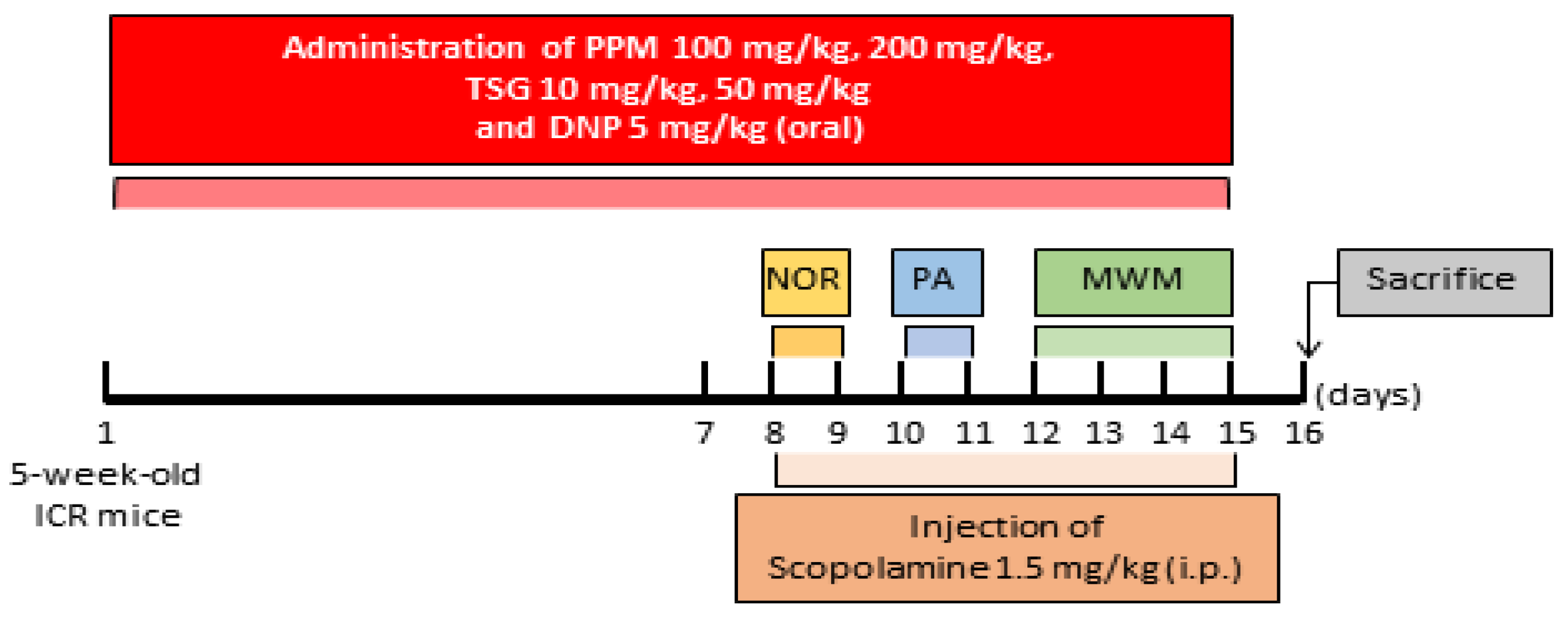
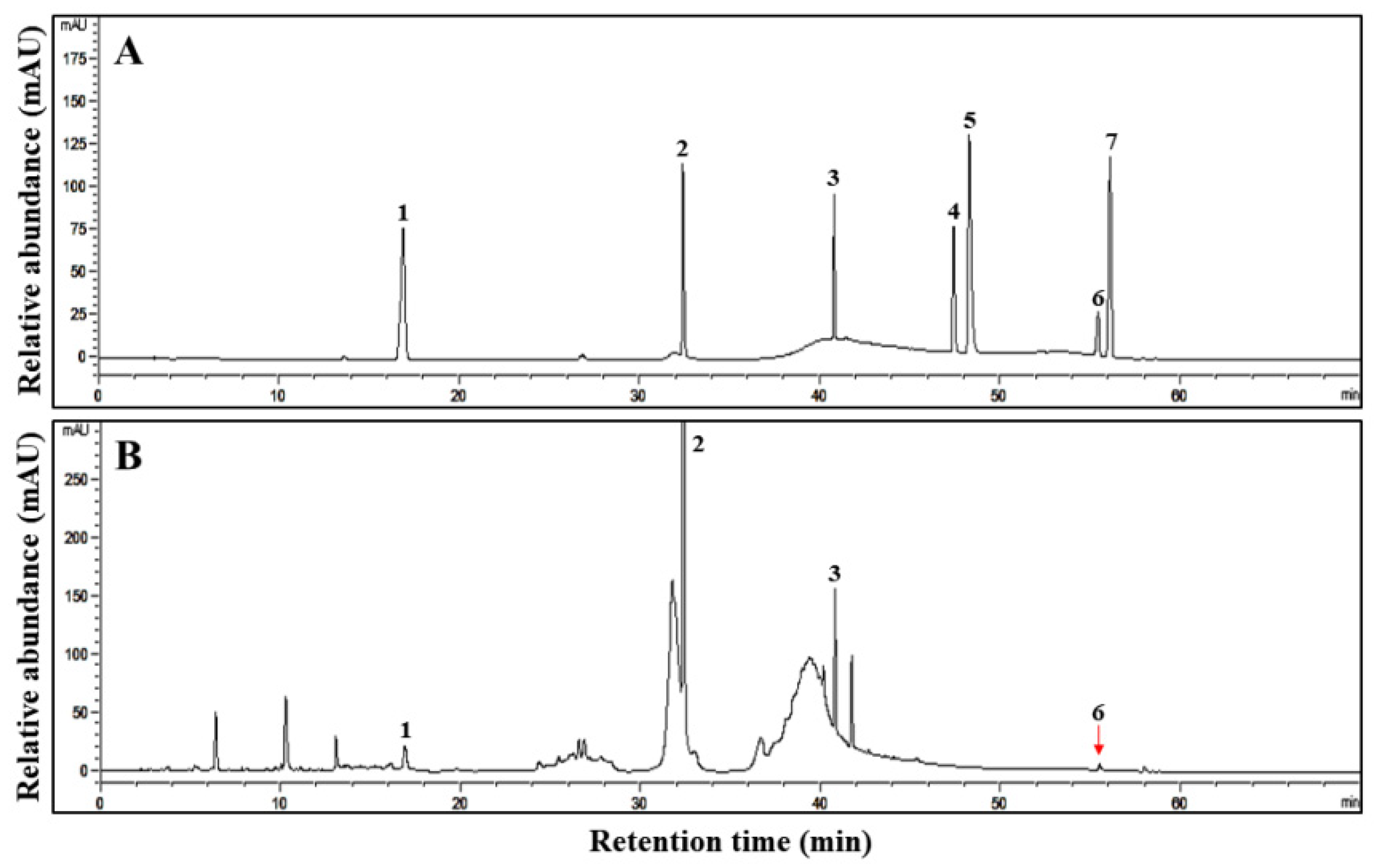


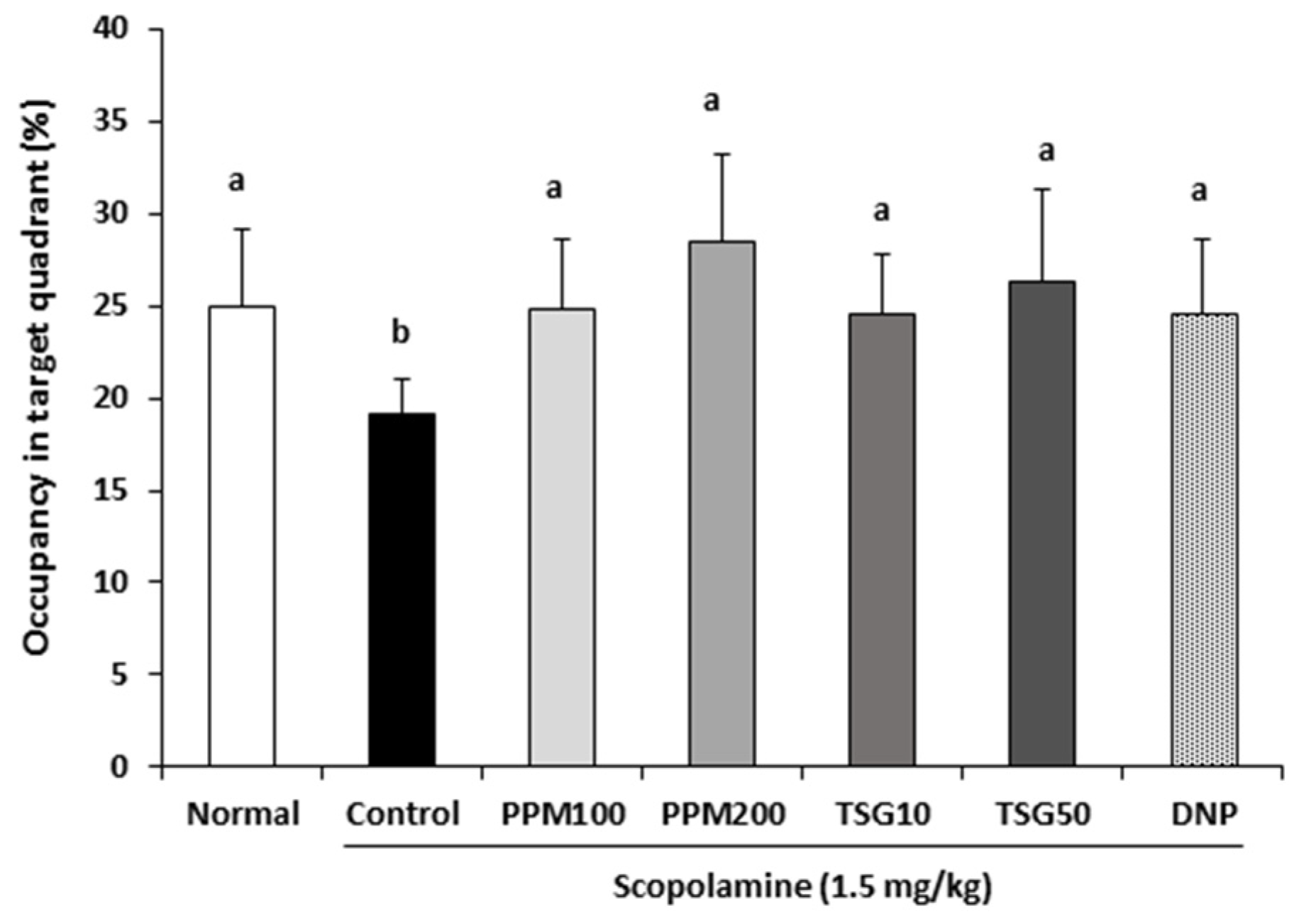

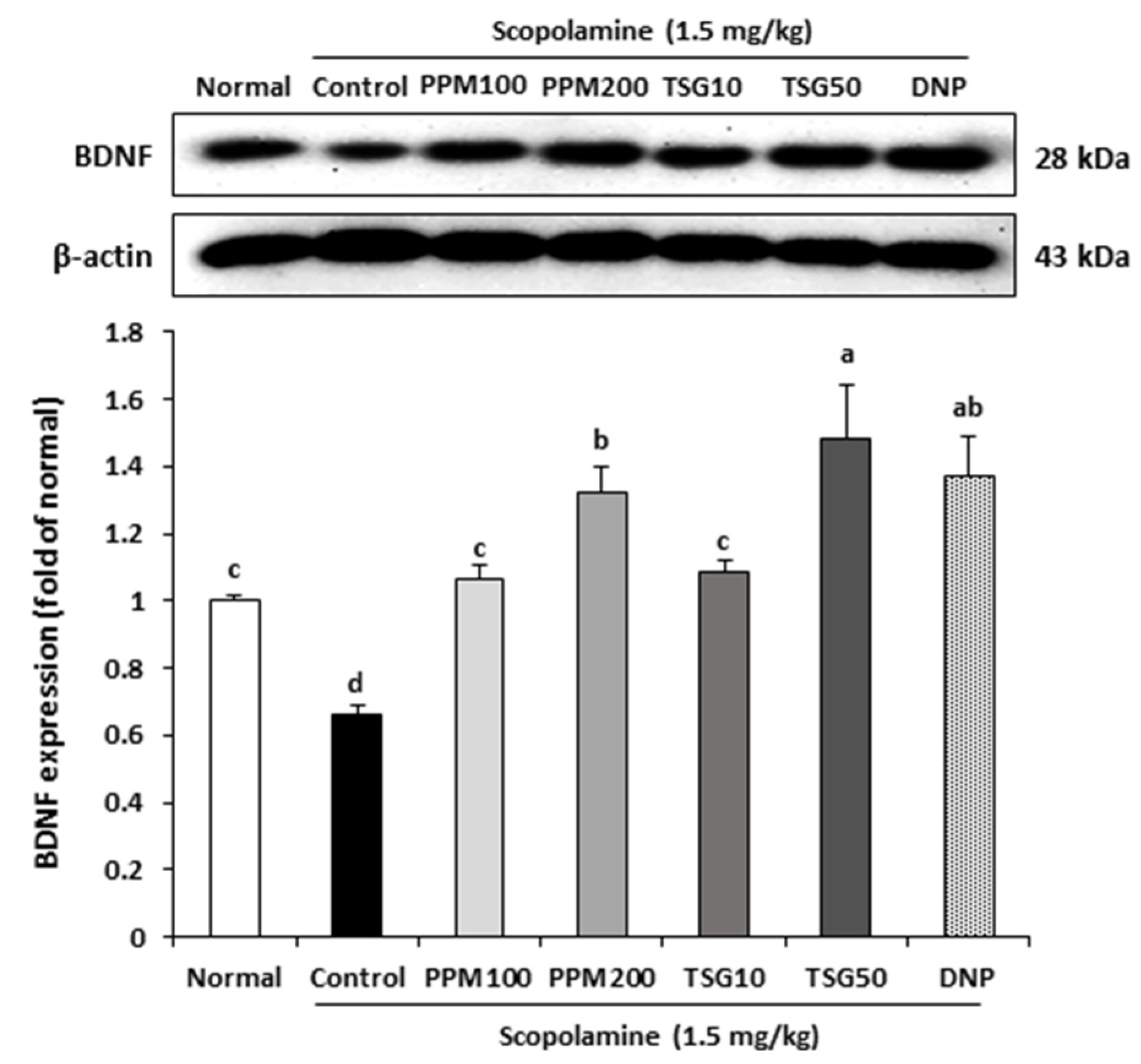
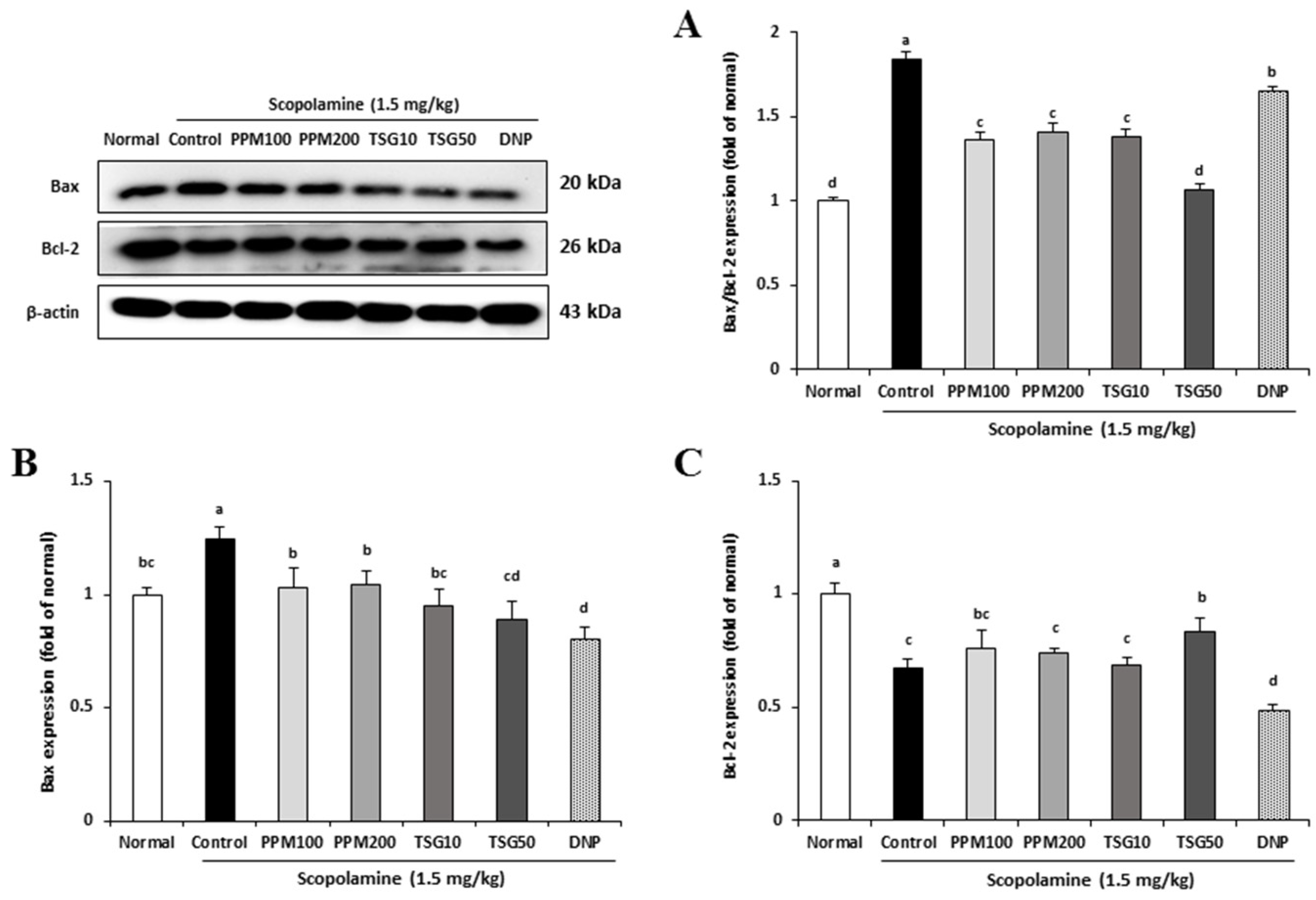
| Phytochemical Compounds | Contents 1 (mg/g) |
|---|---|
| Catechin | 0.43 ± 0.03 c |
| 2,3,5,4′-tetrahydroxystilbene-2-O-β-glucoside (TSG) | 18.81 ± 0.75 a |
| Emodin-8-O-β-d-glucopyranoside (EG) | 0.23 ± 0.02 b |
| Questin | nd 2 |
| Rhein | nd |
| Emodin | 0.21 ± 0.01 b |
| Chrysophanol | nd |
Publisher’s Note: MDPI stays neutral with regard to jurisdictional claims in published maps and institutional affiliations. |
© 2021 by the authors. Licensee MDPI, Basel, Switzerland. This article is an open access article distributed under the terms and conditions of the Creative Commons Attribution (CC BY) license (http://creativecommons.org/licenses/by/4.0/).
Share and Cite
Kim, J.-H.; Kim, J.H.; He, M.T.; Kim, S.C.; Hwa, K.P.; Cho, K.M.; Cho, E.J. Protective Effect of Processed Polygoni multiflori Radix and Its Major Substance during Scopolamine-Induced Cognitive Dysfunction. Processes 2021, 9, 342. https://doi.org/10.3390/pr9020342
Kim J-H, Kim JH, He MT, Kim SC, Hwa KP, Cho KM, Cho EJ. Protective Effect of Processed Polygoni multiflori Radix and Its Major Substance during Scopolamine-Induced Cognitive Dysfunction. Processes. 2021; 9(2):342. https://doi.org/10.3390/pr9020342
Chicago/Turabian StyleKim, Ji-Hyun, Ji Hyun Kim, Mei Tong He, Su Cheol Kim, Kyung Pan Hwa, Kye Man Cho, and Eun Ju Cho. 2021. "Protective Effect of Processed Polygoni multiflori Radix and Its Major Substance during Scopolamine-Induced Cognitive Dysfunction" Processes 9, no. 2: 342. https://doi.org/10.3390/pr9020342
APA StyleKim, J.-H., Kim, J. H., He, M. T., Kim, S. C., Hwa, K. P., Cho, K. M., & Cho, E. J. (2021). Protective Effect of Processed Polygoni multiflori Radix and Its Major Substance during Scopolamine-Induced Cognitive Dysfunction. Processes, 9(2), 342. https://doi.org/10.3390/pr9020342






